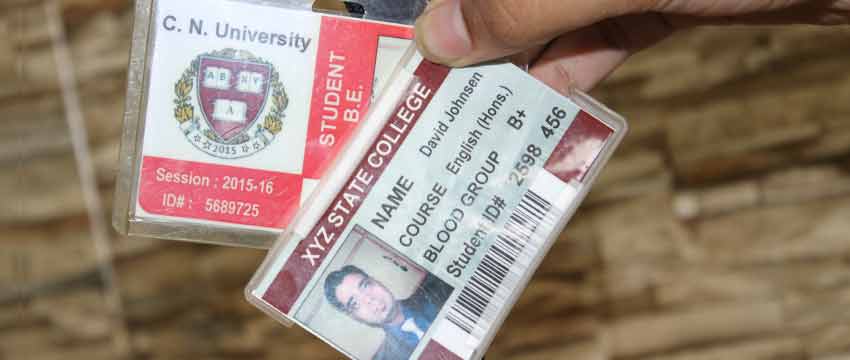Training or Support Resources Available for Using Student ID Badge Designing Software
Yes, there are various training and support resources available for using Student ID Badge designing software. These resources aim to assist users in understanding the software's features, maximizing its functionality, and troubleshooting any issues that may arise.

Here are some common types of resources you can expect:
-
User Manuals and Documentation:
Most software products provide comprehensive user manuals or documentation that explain the software's features, settings, and usage instructions.
These resources typically cover topics such as creating ID badges, customizing designs, managing data, and performing common tasks within the software.
User manuals may be provided in electronic formats (PDF, online help systems) or accessible directly within the software's interface.
-
Webinars and Training Sessions:
Some software vendors organize webinars or training sessions to provide in-depth training on using their software.
Webinars are typically live online presentations that cover various aspects of the software, including best practices, advanced techniques, and new features.
Training sessions may be conducted remotely or on-site and can be tailored to specific user groups or organizations, offering hands-on guidance and interactive learning opportunities.
-
Online Knowledge Bases and FAQs:
Software vendors often maintain online knowledge bases or FAQs (Frequently Asked Questions) that provide answers to common queries and issues.
These resources allow users to search for specific topics or browse through a collection of articles to find relevant information and solutions.
Knowledge bases and FAQs may cover topics ranging from basic usage instructions to advanced troubleshooting and configuration options.
-
Community Forums and Support Portals:
Community forums or support portals hosted by the software vendor or user communities can be valuable resources for sharing knowledge and seeking assistance.
Users can post questions, share experiences, and receive responses from the vendor's support team or other knowledgeable community members.
These platforms often include searchable archives of past discussions, providing a wealth of information on common issues and solutions.
-
Tutorials and Video Guides:
Many software vendors offer tutorials and video guides that demonstrate how to use specific features or accomplish certain tasks.
These resources can be in the form of step-by-step written tutorials, video tutorials, or a combination of both.
Tutorials often cover topics like badge design, template creation, database integration, printing options, and advanced customization.
-
Customer Support Channels:
Software vendors typically offer customer support through various channels, such as email, live chat, or telephone.
Users can reach out to the vendor's support team to seek assistance with technical issues, feature inquiries, or general questions related to the software.
It's important to review the support policies and availability of support channels provided by the software vendor, as they may vary.
-
Online Help within the Software:
Many software applications feature built-in help systems accessible directly from within the software's interface.
Online help provides context-sensitive assistance, allowing users to access relevant information and instructions based on their current location or task within the software.
Users can typically find explanations, tips, and step-by-step instructions on various features and functions by accessing the help system.
In conclusion, the most useful keyboard shortcuts and tools in label designer software include copy and paste, undo and redo, selection, duplication, nudging, find and replace, font dialog, grouping and ungrouping, layers, grids and guides, templates and design libraries, barcode and QR code support, color management, and preview and printing. By using these keyboard shortcuts and tools, you can work more efficiently and effectively, saving time and creating high-quality labels that meet your specific needs.
Important Features of Student ID Badge Software
When considering student ID badge designing software, there are several important features to look for that can enhance the design process, security, and functionality of the ID badges. Here are some key features to consider:

A good ID badge designing software should provide a range of customization options. This includes the ability to add logos, images, and text, choose from various fonts and colors, and adjust the layout of the ID badge. The software should allow for flexibility in design to match the institution's branding and specific requirements.
Template Library:A template library is a valuable feature that provides pre-designed ID badge templates for different purposes. These templates can be customized to suit specific needs, saving time and effort in the design process. Having a diverse selection of templates allows for flexibility and caters to different design preferences.
Photo Integration:The software should offer the capability to incorporate student photographs into the ID badge design. This feature ensures that each ID badge includes a clear and recognizable photo of the student, enhancing identification and security measures. The software should support easy photo importing and editing capabilities, such as cropping or adjusting the image.
Barcode, QR Code, or RFID Integration:To enhance security and functionality, the software should support the integration of barcodes, QR codes, or RFID technology on the ID badges. These features enable access control, attendance tracking, or secure entry to specific areas within the institution. The software should allow for the generation and customization of these codes, as well as provide compatibility with existing systems.
Data Import and Integration:An important feature is the ability to import student data from existing databases or student information systems. This ensures accuracy and consistency in the information displayed on the ID badges. The software should support data integration through common file formats or have direct integration capabilities with popular student information systems.
Print Options and Compatibility:Consider whether the software allows for easy printing of ID badges. It should offer options for printing on standard ID card sizes and be compatible with common ID card printers. The software should also support batch printing, enabling administrators to print multiple ID badges simultaneously.
Security and Encryption:Security is crucial when dealing with student ID badges. Look for software that provides encryption and security features to protect sensitive student information. This includes secure storage of data, password protection, and restricted access to the software itself.
User-Friendly Interface:A user-friendly interface is important to ensure ease of use and efficiency in the design process. The software should have intuitive navigation, drag-and-drop functionality, and a clear workflow. It should be accessible to users with varying levels of technical expertise.
Technical Support and Updates:Consider the availability of technical support and regular software updates. Reliable customer support can assist with any issues or questions that may arise during the design process. Regular updates ensure that the software remains compatible with the latest operating systems and incorporates new features or security enhancements.
Cost and Licensing:Evaluate the cost structure and licensing options of the software. Determine whether it is a one-time purchase or subscription-based. Consider any additional costs, such as support fees or upgrades, to make an informed decision based on your institution's budget and requirements.
By considering these important features, you can select student ID badge designing software that meets your institution's needs, enhances security, and streamlines the ID badge design process.